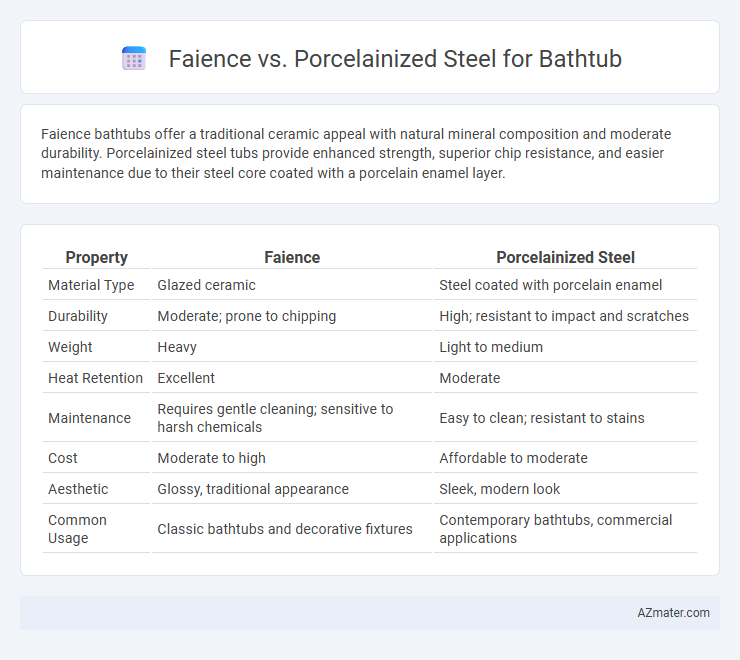Faience bathtubs offer a traditional ceramic appeal with natural mineral composition and moderate durability. Porcelainized steel tubs provide enhanced strength, superior chip resistance, and easier maintenance due to their steel core coated with a porcelain enamel layer.
Table of Comparison
| Property | Faience | Porcelainized Steel |
|---|---|---|
| Material Type | Glazed ceramic | Steel coated with porcelain enamel |
| Durability | Moderate; prone to chipping | High; resistant to impact and scratches |
| Weight | Heavy | Light to medium |
| Heat Retention | Excellent | Moderate |
| Maintenance | Requires gentle cleaning; sensitive to harsh chemicals | Easy to clean; resistant to stains |
| Cost | Moderate to high | Affordable to moderate |
| Aesthetic | Glossy, traditional appearance | Sleek, modern look |
| Common Usage | Classic bathtubs and decorative fixtures | Contemporary bathtubs, commercial applications |
Introduction to Bathtub Materials
Faience bathtubs, crafted from glazed ceramic, offer a luxurious, glossy finish with excellent resistance to stains and scratches, making them a timeless choice in bathroom design. Porcelainized steel bathtubs combine the strength of steel with a smooth porcelain enamel coating, delivering durability and quick heat retention for a comfortable bathing experience. Both materials provide distinctive benefits in terms of aesthetics, maintenance, and longevity, influencing the selection based on user preference and bathroom decor.
What is Faience?
Faience is a type of glazed ceramic material known for its porous body and vibrant, colorful finish, commonly used in decorative tiles and sanitary ware. Unlike porcelainized steel, faience offers a more authentic, handcrafted aesthetic with a natural feel but requires more maintenance due to its susceptibility to chipping and staining. This ceramic material is favored for its artistic appeal and traditional craftsmanship in bathroom fixtures like bathtubs.
Understanding Porcelainized Steel
Porcelainized steel bathtubs combine a steel base coated with a durable porcelain enamel layer, offering high resistance to chipping, scratching, and staining compared to faience. The porcelain enamel provides a smooth, non-porous surface that is easy to clean and maintains its glossy appearance over time. This combination delivers strength and longevity, making porcelainized steel a cost-effective option with better durability and low maintenance compared to traditional ceramic faience tubs.
Durability Comparison: Faience vs Porcelainized Steel
Faience bathtubs, made from glazed ceramic, offer commendable resistance to scratching and chipping but are more prone to cracking under heavy impact compared to porcelainized steel. Porcelainized steel bathtubs combine a steel core with a porcelain enamel coating, delivering superior impact resistance and enhanced durability against dents and structural damage. Both materials provide long-lasting use, but porcelainized steel excels in withstanding heavy wear and maintaining structural integrity over time.
Aesthetic Differences and Design Options
Faience bathtubs offer a classic, artisanal aesthetic with intricate glaze finishes and vibrant color variations that lend a timeless charm to bathroom designs. Porcelainized steel bathtubs present a sleek, modern look characterized by smooth, glossy surfaces and uniform color palettes, enhancing minimalist and contemporary settings. Design options for faience include handcrafted patterns and textured finishes, while porcelainized steel favors clean lines and durable, easy-to-maintain coatings ideal for varied bathroom styles.
Maintenance and Cleaning Requirements
Faience bathtubs require gentle cleaning with non-abrasive, pH-neutral cleaners to avoid surface damage and staining, while porcelainized steel bathtubs offer a more durable, chip-resistant enamel surface that withstands harsher scrubbing and common household cleaning agents without compromising finish. Faience surfaces are more porous and susceptible to discoloration if not regularly sealed, whereas porcelainized steel is non-porous and resists mildew formation, reducing maintenance frequency. Both materials benefit from prompt removal of soap scum and mineral deposits, but porcelainized steel generally demands less intensive upkeep due to its harder, smoother coating.
Cost Analysis: Affordability of Each Material
Faience bathtubs typically offer a more affordable initial purchase price compared to porcelainized steel, making them a cost-effective choice for budget-conscious homeowners. Porcelainized steel, while generally more expensive upfront, provides superior durability and resistance to chipping, which can reduce long-term maintenance and replacement expenses. Evaluating total cost of ownership, including installation, repair, and lifespan, helps determine the most economical option between these two materials.
Installation Process and Considerations
Faience bathtubs typically require more careful handling during installation due to their fragile ceramic nature, demanding precise leveling and secure support to prevent cracking. Porcelainized steel tubs offer easier installation, featuring lighter weight and greater durability, allowing for straightforward placement and stable anchoring to existing frames. Both materials necessitate proper sealing and precise measurements, but porcelainized steel's resilience reduces risk during handling and may shorten installation time.
Environmental Impact and Sustainability
Faience bathtubs, made from natural clay and minerals, offer biodegradability and lower energy consumption during production compared to porcelainized steel, which involves steel substrate coated with vitreous enamel, requiring high-temperature kiln firing and metal extraction processes. Porcelainized steel provides durability and longevity, reducing waste through extended use and recyclability of steel, but it carries a higher carbon footprint due to mining and enamel application. Choosing faience supports eco-friendly manufacturing and natural material use, while porcelainized steel benefits from recycling potential and robustness in sustainable bathroom design.
Choosing the Best Material for Your Bathroom
Faience offers a classic, glossy finish with excellent heat retention and a natural ceramic feel, making it ideal for traditional bathroom aesthetics. Porcelainized steel combines a durable steel core with a porcelain enamel coating, providing superior resistance to impacts, scratches, and stains while being lighter and easier to install. When choosing the best material for your bathtub, consider faience for its timeless elegance and warmth, or porcelainized steel for its modern durability and low maintenance requirements.

Infographic: Faience vs Porcelainized Steel for Bathtub
 azmater.com
azmater.com